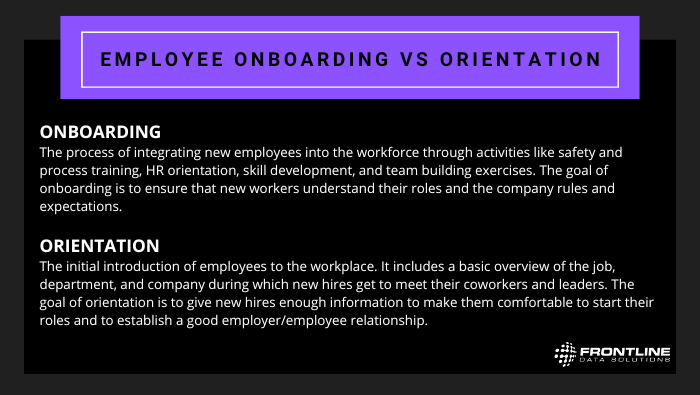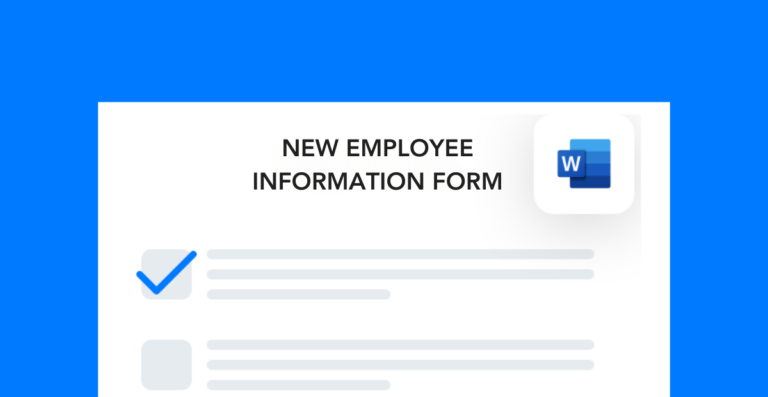Shifting your focus: orientation versus onboarding
According to a 2019 Gallup study, “employees with an exceptional onboarding experience are 2.6 times as likely to be extremely satisfied with their place of work.” But not all companies put emphasis on the right elements of this process.
One major mistake is focusing too much on orientation versus onboarding. Companies that make a lasting impression are the ones that understand how valuable those first few weeks and months are to new employees. If you shift your focus to the entire onboarding experience, you may be able to raise retention rates and gain more credibility among prospects in the labor market.
Defining orientation and onboarding
The terms “orientation” and “onboarding” are often used interchangeably, but they are not the same. Onboarding is the entire process of fully integrating new workers into the organization. Orientation is just one step in that larger process.
From start to finish, onboarding involves all the training, informational sessions, HR support, team building, and administrative work that happens when you hire a new employee.
By the end of this process, your employees should be fully integrated into the organization and have all the information and tools they need to succeed. On the other hand, orientation simply serves as an introduction to a worker’s new role and isn’t meant to cover all the ins and outs of the job.
Many companies are missing out on the benefits of having a comprehensive approach to both onboarding and orientation. Typically, the brands that focus on onboarding, rather than just the first few interactions during orientation, will have better long-term success engaging and retaining their employees.

Auditing your onboarding process
The first step in improving your employees’ onboarding experience is auditing what you currently have in place. You don’t need a fancy method to do this. Simply start by writing out the answers to these questions:
- What is the average timeline from when someone is hired to their first day?
- How do new hires receive information about their first day on the job?
- How long does the new hire orientation take?
- What are all the steps in the onboarding process?
- How much training (in hours) do employees receive during their onboarding?
- What does your company do to make the onboarding process fun and engaging?
There are a couple of key insights to look for during this audit.
First, you want to determine how much of the onboarding process is active versus passive. In other words, does your onboarding process involve you throwing a bunch of information at new hires or is it more collaborative, allowing them to ask questions and make decisions?
Second, you need to think about the amount of time onboarding takes and whether there is scrap that you can remove. For example, do you have redundancies in your training materials that might cause new hires to zone out during presentations? Focusing on small details like this can have a much bigger impact on the overall experience than you might realize.
The final area you want to look at is whether the onboarding process is user friendly or overly complicated. How many different teachers/presenters do new hires interact with in the first week? Do they receive several emails containing critical information in the weeks leading up to their first day?
If the process is scattered and involves too many stakeholders, your new hires might get overwhelmed.
Creating an excellent experience
Thinking of your new hires like customers is an easy way to shift your mindset towards creating an excellent onboarding experience for them. This means that you want your first interactions with them to be insightful, engaging, and most of all positive. Below are some tips for achieving those types of interactions.
Simplify communication
Try to reduce the number of times and ways you contact new hires before they first arrive onsite. This means consolidating important information into comprehensive resources.
A great example is an onboarding packet which includes the date, time, and location of orientation. You can also include information like benefit sign ups, time off accruals, and the first week’s schedule. Simplifying how you communicate these details can ease the anxiety that many people feel during their first week at a new company.
Schedule training early
The last thing you want to happen is to have new employees show up for orientation and not have their schedule for the rest of the week. When new hires arrive onsite, you should be able to tell them exactly what they will learn throughout the onboarding process.
This involves scheduling training sessions, assigning trainers, and reserving equipment/rooms far in advance. The more organized you are when scheduling training, the more efficient your onboarding will be.
Track onboarding actions
Creating a great onboarding experience is easier when you have an organization system in place. The best way to create this type of system is to automate and streamline your onboarding tasks.
Action tracking software is a great tool for coordinating cross-functional tasks. From a central location, you can assign, view, and manage all pending and completed action items. This makes it easier to oversee the onboarding process and translates to a smoother experience for your new hires.
Keep orientation short
Orientation should be the shortest step in the onboarding process. Since it’s designed to be an introduction, you don’t want to spend this time overloading workers with information.
Instead, focus on how excited you are for them to join the company. Give them a chance to see their work areas, meet their coworkers and bosses, and get acquainted with their new roles.
Bundle administrative tasks
Oftentimes, companies scatter administrative tasks over several days or weeks, making it difficult for workers to settle in. By bundling these tasks within the initial onboarding process, you help your employees solve HR problems so they can focus on the roles they were hired to complete.
Consider sending workers forms to sign before they come for orientation. That way, you’ll have all the documentation finished quickly and workers can prepare any questions they may have ahead of time, making the process smoother.
Coordinate fun
Not all parts of orientation and training will be fun. But that doesn’t mean you can’t have any at all. Identify the most boring and tedious areas of the process and coordinate fun activities to break them up.
This keeps workers engaged even during the roughest parts of onboarding. Plus, it can be a good way to show them exactly what type of culture your company offers. Establishing a clear brand personality in the first week or month can transform your company’s employee turnover rates for the long haul.
Making a lasting impresion
The onboarding process will make a lasting impression on your workforce. The question is: will that impression be positive or negative? If you focus more on orientation than the entire onboarding experience, you’re missing out on many opportunities to build strong relationships with new hires.
Being organized and consistent is the key to a successful onboarding program. When you’re organized, you make those first few days and weeks much easier on your new employees. And that gives them the space to confidently settle into their new roles—strengthening your organization at the same time.
Other posts you might like…
No posts

